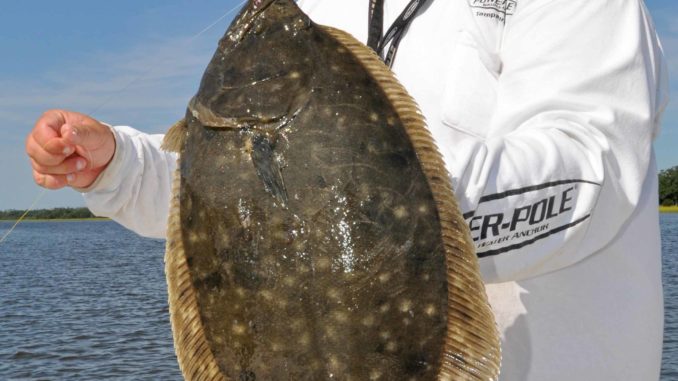
Fish beginning migration toward ocean, feeding up for winter
Fall flounder fishermen usually look to inshore waters as flatfish migrate toward the ocean, following baitfish that head out, anticipating the first rush of cold weather that’s a harbinger of winter. But Robbie Hall of Swansboro’s Hall Em In Charters is one of only a relative few anglers who directs his attention toward the marsh behind Bear Island and Brown’s Island south of his hometown and the same-named inlets that bracket them, both of which comprise Hammocks Beach State Park. “I’ve had really good days recently,” said Hall (910-330-6999). “Two clients recently caught their limit of flounder in about two hours. Of course, the key is finding a spot with fish. Sometimes it takes a while.”
Best places to target flounder the edges of marsh islands out to about 8 feet off the marsh grass. A feeder creek out of the marshes coming into a larger creek also is a good spot, as are oyster beds.
Being on the water four to five days a week allows Hall the time to find hot stretches of marsh without having to search for hours during a guide trip.
Recently, he’s been catching fish in the marsh creeks and bays behind Bear Island, whose northern tip ends at Bogue Inlet.
And the five or six weeks will be prime time for catching flounder near inlets.
“Summer and southern flounder move toward the ocean this time of year,” said Hall. “The summer flounder move through the inlets in the summer, then out into the ocean. I think the southern flounder just follow the baitfish to the inlets then up and down the beaches.”
Finger mullet, menhaden and big shrimp are their prime food sources. Shrimp also migrate in the fall fall, and alert anglers can detect them flipping on the surface. A quick hand with a cast net can enough shrimp for an 8-hour excursion.
“You also can use a Carolina-rigged finger mullet or shrimp or scented soft-plastic artificial lures for flounder,” said Hall, who prefers a 4-inch Gulp! shrimp on an eighth- or quarter-ounce jighead, depending on the current.
“The fishing’s only going to get better into October,” he said, “until the water gets cold enough to push all the baitfish and flounder out of the marshes and creeks.
“I’m also finding flounder near the inlets, too, near where the inlet meets the ICW and turns north or south.”
Hall likes to cast, let his lure sink, then hop it off the bottom a few times while taking up the slack line.
One great thing about using artificials is they will withstand raids by pinfish, which are notorious for stealing live shrimp. And, when a flounder decides to eat a soft-plastic lure, there’s no waiting. As soon as an angler feels resistance, a flounder has the plastic in its mouth and it’s time to set the hook.


Be the first to comment